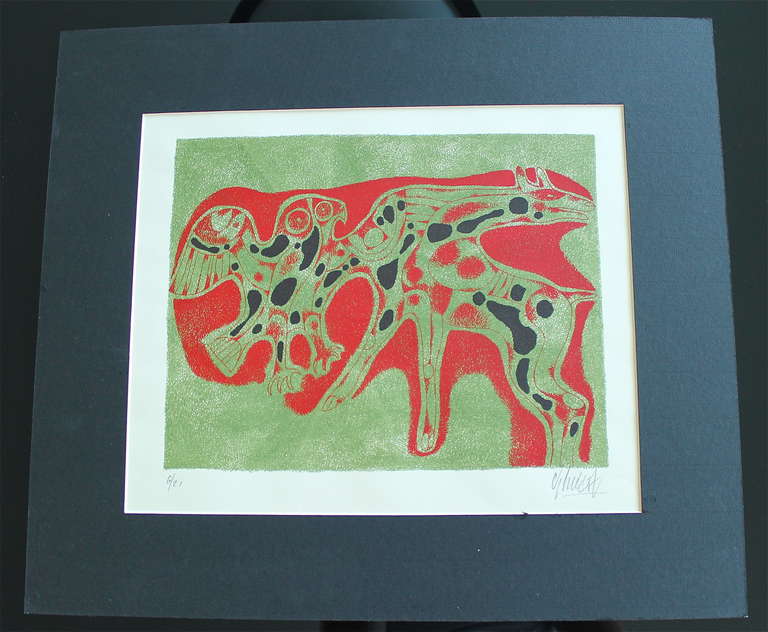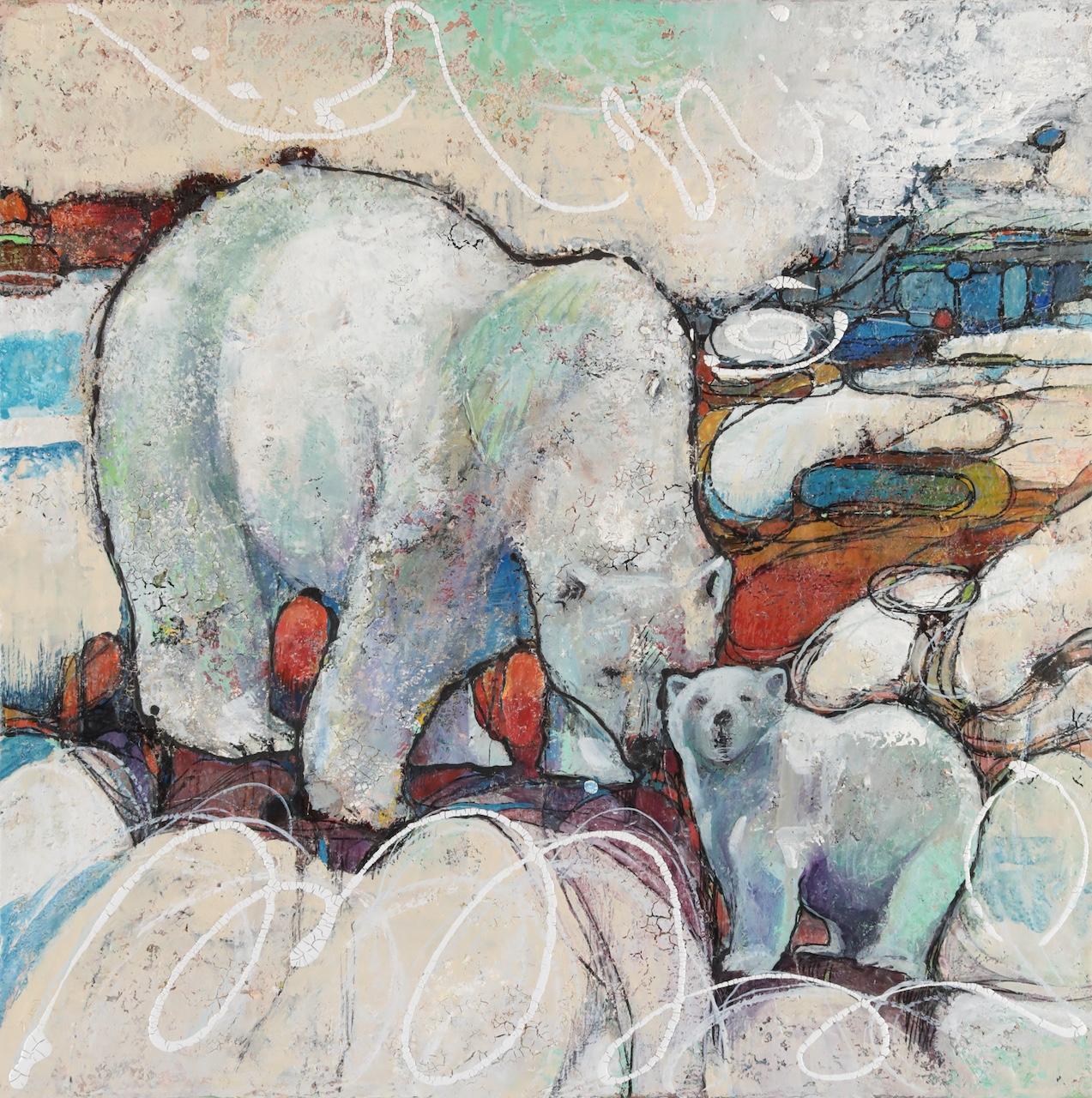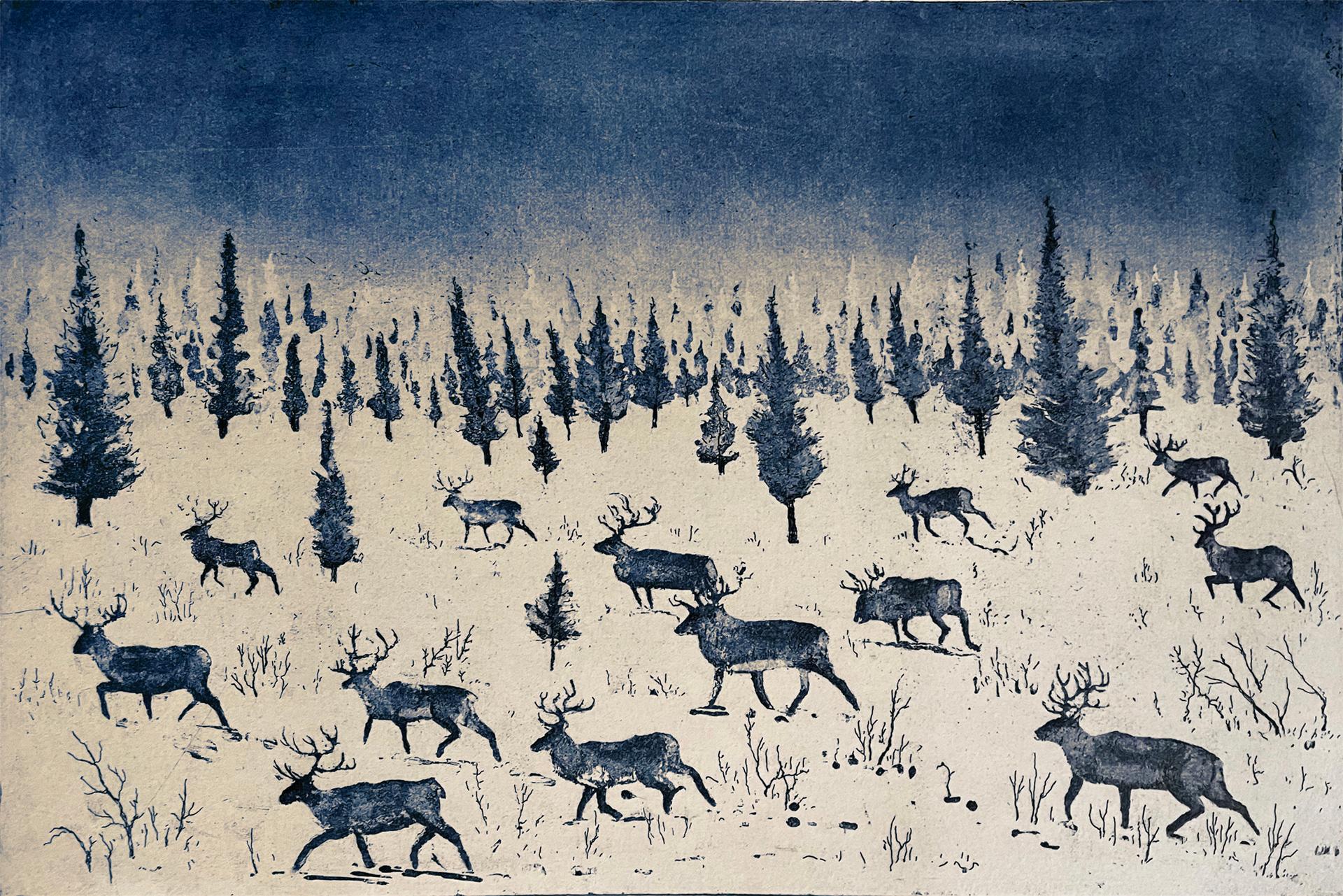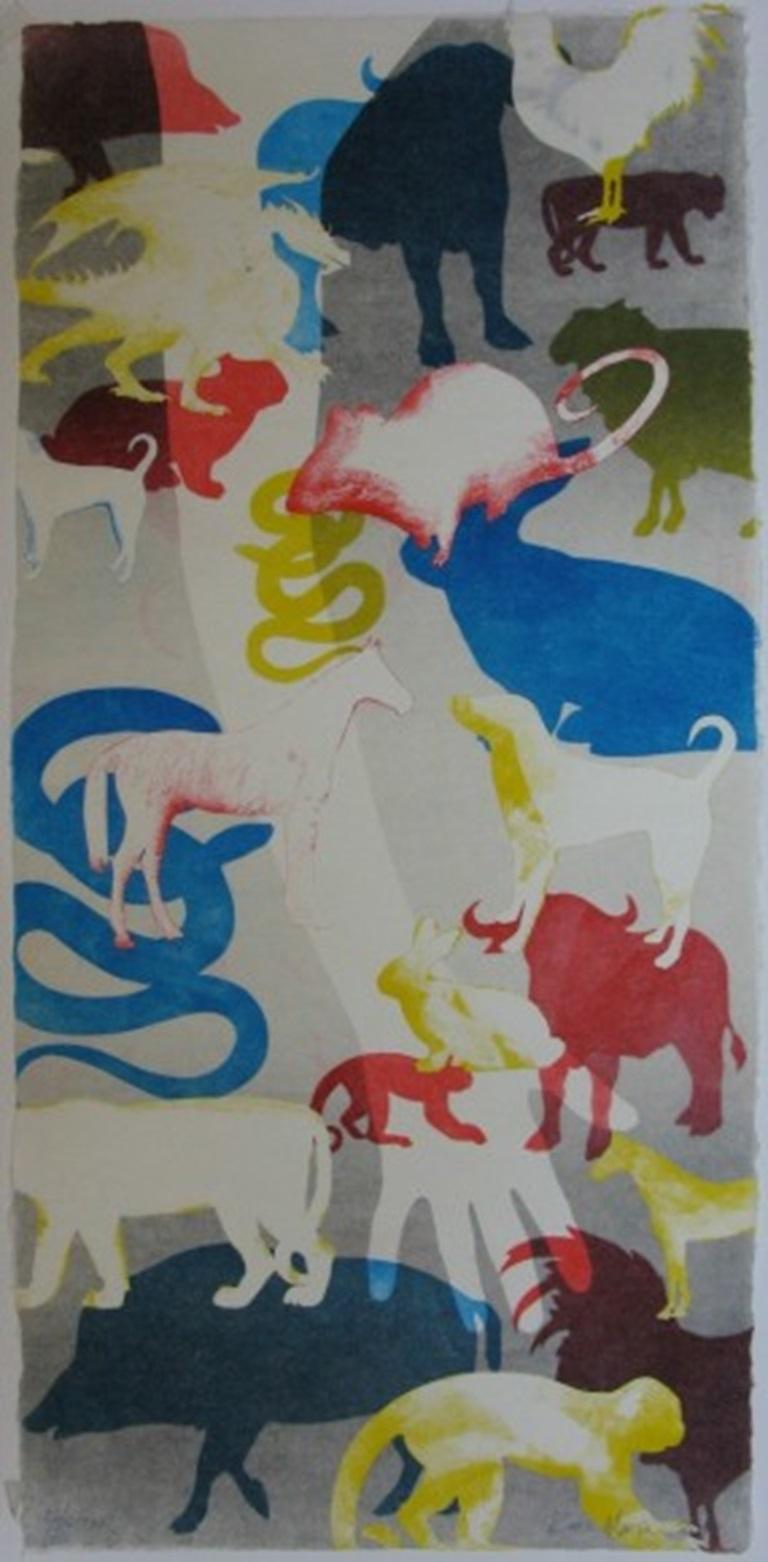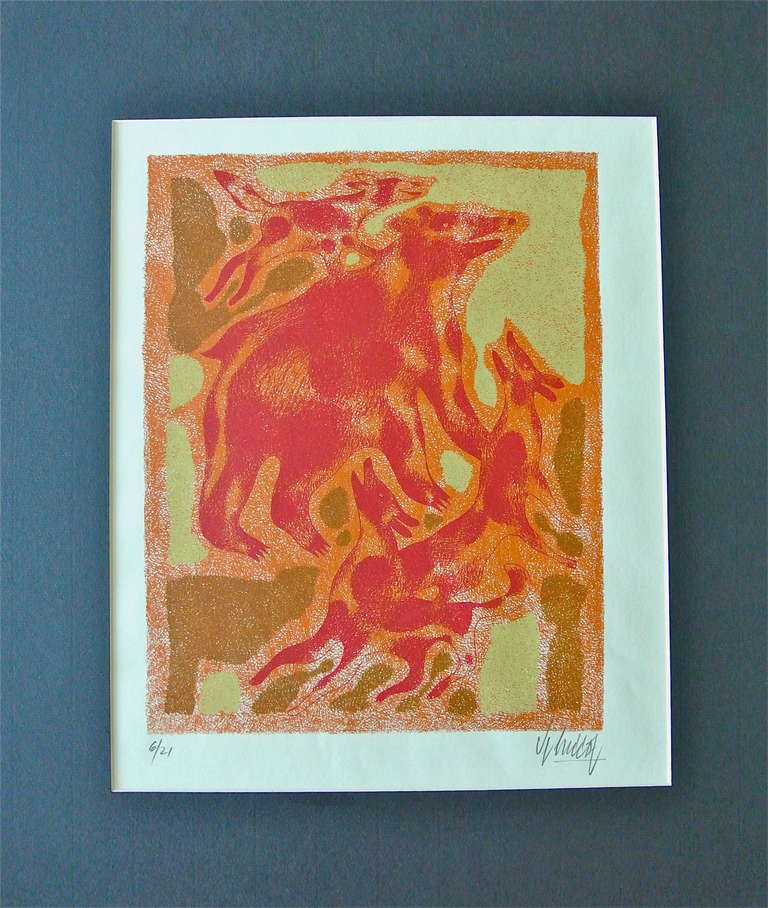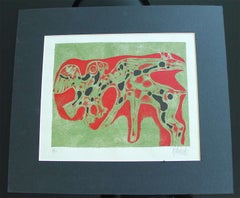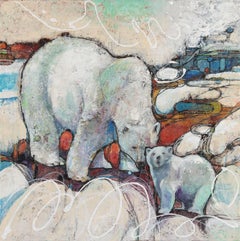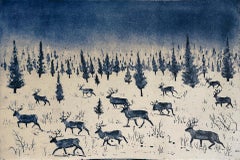Items Similar to Winter Dream
Want more images or videos?
Request additional images or videos from the seller
1 of 13
Pudlo PudlatWinter Dream1989
1989
$1,300
£981.71
€1,123.97
CA$1,835.94
A$2,004.41
CHF 1,050.83
MX$24,344.29
NOK 13,123.14
SEK 12,391.74
DKK 8,389.20
About the Item
This artwork titled "Winter Dream" 1989 is an original stonecut on thin tissue paper by noted Canadian/Inuit artist Pudlo Pudlat, 1916-1992. It is hand signed, titled, dated. described, located and numbered 16/50 in pencil by the artist. The stone mark (image) size is 11.75 x 14 inches, framed size is 24.35 x 26.5 inches. Custom framed in a wooden maple color frame, with off white matting and yellow fillet. it is in excellent condition.
About the artist:
Pudlo Pudlat, graphic artist (born 4 February 1916 in Kamadjuak Camp, Baffin Island, NWT; died 28 December 1992 in Cape Dorset, NWT). One of the most original contemporary Inuit artists, Pudlo Pudlat included in his imagery icons of the modern technology that has brought such profound changes to the Canadian North. Working in a combination of acrylic wash and coloured pencils, at his death he had completed 4,500 drawings, around 200 of which had been turned into prints, and several sculptures.
Until Pudlo was six years old, he and his family lived near Coral Harbour and later moved to the Lake Harbour region, now called Kimmirut. Until he was in his 40s, he lived as a semi-nomadic hunter and fisherman, travelling along the southwest coast of Baffin Island. In the late 1950s, Pudlo moved to Kiaktuuq, near Cape Dorset, in order to recover from tuberculosis. It was there that he met James Houston, founding director of the West Baffin Eskimo Co-operative, and began making art. Encouraged by Houston and then by Houston’s successor, Terry Ryan, he started out carving, but found it difficult because of an arm injury and switched to drawing in 1959 or 1960. Eventually, Pudlo practiced printmaking, painting with acrylic paint and drawing with graphite pencils, coloured pencils and felt-tip markers.
Pudlo was in a unique position to witness the transformations of traditional Inuit life in the 1950s, from a semi-nomadic lifestyle to a settled one, and also by the introduction of modern technology into the Arctic. This transformation is depicted in his art. In Pudlo’s work, airplanes, helicopters and telephone poles enter into strange interactions with the Arctic landscape and its animals. A muskox rider lassoing an airplane or a loon steering a motorboat are examples of his juxtapositions. In many ways Pudlo's work symbolizes the paradoxes of the encounter between Inuit and Western culture. In an untitled painting from the 1980s, for instance, there is a cluster of simple houses in the foreground; in the middle ground there is a telephone pole and an antenna set on immense boulders, and along the treeless horizon are two hunters dark and barely discernible, wielding spears and knives. Above it all are two jets amidst the sky and blue clouds. The painting partly illustrates a strange surrealism that occurs when the traditional lifestyle of the Inuit is set in the context of modern technologies and amenities. In the colour drawing from 1990, Old and New, hunters in canoes paddle across the water toward a gigantic goose surrounded by her goslings, a jet swooping above them. In Old and New what one most notices is not just the comically huge goose but the almost comic difference in scale between modern technologies, the natural world and human beings.
Pudlo Pudlat’s works are in the collections of most Canadian museums, including the National Gallery of Canada, and some international institutions. His art has been featured in solo exhibition across Canada, the United States and Europe. In 1990, the National Gallery of Canada organized a retrospective exhibition of his drawings, Pudlo: Thirty Years of Drawing, and mounted another major exhibition, Pudlo Pudlat: A Celebration, in 1993. In the same year, there was a solo exhibition of his work, Pudlo Pudlat: A Meeting of Cultures, at the McMichael Canadian Art Collection.
- Creator:Pudlo Pudlat (1916 - 1992, Canadian)
- Creation Year:1989
- Dimensions:Height: 24.35 in (61.85 cm)Width: 26.5 in (67.31 cm)Depth: 1.25 in (3.18 cm)
- Period:
- Condition:
- Gallery Location:San Francisco, CA
- Reference Number:Seller: pud/win/dre/011stDibs: LU666311029412
About the Seller
5.0
Platinum Seller
Premium sellers with a 4.7+ rating and 24-hour response times
Established in 1999
1stDibs seller since 2017
841 sales on 1stDibs
Typical response time: 1 hour
- ShippingRetrieving quote...Shipping from: San Francisco, CA
- Return Policy
Authenticity Guarantee
In the unlikely event there’s an issue with an item’s authenticity, contact us within 1 year for a full refund. DetailsMoney-Back Guarantee
If your item is not as described, is damaged in transit, or does not arrive, contact us within 7 days for a full refund. Details24-Hour Cancellation
You have a 24-hour grace period in which to reconsider your purchase, with no questions asked.Vetted Professional Sellers
Our world-class sellers must adhere to strict standards for service and quality, maintaining the integrity of our listings.Price-Match Guarantee
If you find that a seller listed the same item for a lower price elsewhere, we’ll match it.Trusted Global Delivery
Our best-in-class carrier network provides specialized shipping options worldwide, including custom delivery.More From This Seller
View AllFish Become Birds
Located in San Francisco, CA
This artwork titled "Fish Become Birds" 1999 is an original colors stonecut on thin tissue paper by Canadian/ Inuit artist Kavavaow (Kavavau) Mannomee, b.1958. It is hand signed, titled, located, dated, described and numbered 4/50 in pencil by the artist. The subject size is 16 x 23.25 inches, sheet size is 24.5 x 29 inches. It is in excellent condition.
About the artist:
Qavavau born in Brandon, Manitoba in 1958 where his mother, Paunichea, was hospitalized for treatment of tuberculosis. He returned to Cape Dorset...
Category
Late 20th Century Other Art Style Animal Prints
Materials
Other Medium
Silent Hunter
Located in San Francisco, CA
This artwork titled "Silent Hunter" 2002 is an original color stonecut on beige Japan paper by noted Canadian/Inuit artist Kananginak Pootoogook, 1935-2010. It is hand signed, dated, titled, located, described and numbered 22/50 in pencil by the artist. The image size is 15 x 11.75 inches, framed size is 23.35 x 20 inches. Custom framed in a wooden dark green frame, with green matting. It is in excellent condition.
About the artist:
Kananginak Pootoogook was an Inuit sculptor and printmaker who lived in Cape Dorset, Nunavut, in Canada. He died as a result of complications related to surgery for lung cancer.
Pootoogook was born at a traditional Inuit camp called Ikerasak, near Cape Dorset, Nunavut (then in the Northwest Territories) to Josephie Pootoogook, leader of the camp, and Sarah Ningeokuluk. The family lived a traditional lifestyle hunting and trapping while living in an iglu in the winter and a sod house in the summer and did not move into their first southern style house until 1942. In 1957 Pootoogook married Shooyoo, moved to Cape Dorset and began work for James Houston.
Originally, Pootoogook did some carving, made prints and lithographs for other artists. At the same time he was a leader in setting up the West Baffin Eskimo Co-operative, the first Inuit owned co-op, now part of the Arctic Co-operatives Limited and served from 1959 until 1964 as the president. Although Kananginak had worked with his father, Josephie, in 1959, it was not until the 1970s that Kananginak began work as a full-time artist producing drawings, carvings and prints. According to Terry Ryan, former Co-op manager, Pootoogook was both influenced by and an admirer of the works of his uncle, photographer and historian Peter Pitseolak.
The World Wildlife Commission released a limited edition set in 1977 that included four of Pootoogook's images and in 1980 he was elected to the Royal Canadian Academy of Arts. In 1997 Pootoogook built a 6 ft (1.8 m) inukshuk in Cape Dorset for former Governor General of Canada, Roméo LeBlanc. The inukshuk was dismantled and shipped to Ottawa and with the assistance of his son, Johnny, it was rebuilt at Rideau Hall and unveiled on 21 June, National Aboriginal Day.
Pootoogook had several exhibitions and showings of his work. In 2010, he went to Vancouver for the 2010 Winter Olympics and to open a showing of his work at the Marion Scott Gallery. He also had a showing of his work, his first solo exhibition at a public institution, at the Museum of Inuit Art in Toronto from February to May 2010. He also received a 2010 National Aboriginal Achievement Award in the arts category from the National Aboriginal Achievement Foundation.
While working on his final, and unfinished, drawing of a Peterhead owned by his father, he was struck by coughing spells, which he declared was cancer. Along with his wife, Shooyoo, he flew to Ottawa, staying at the Larga Baffin home, and was diagnosed with lung cancer. In October 2010, he underwent surgery and did not recover. He died 23 November 2010 in Ottawa. The work of Kananginak Pootoogook is held in numerous collections and museums, includingThe McCord Museum, the Dallas Museum of Art, Musee National des Baux Arts...
Category
Late 20th Century Other Art Style Figurative Prints
Materials
Other Medium
The Protectress
Located in San Francisco, CA
This artwork titled "The protectress" 1997 is a original stone cut with stencil on thin paper by noted Canadian Inuit artist Kakulu Saggiaktok, 1940-...
Category
Late 20th Century Other Art Style Animal Prints
Materials
Stencil
Sea Spirit
Located in San Francisco, CA
This artwork titled "Sea Spirit" 1965 is an original stonecut on thin paper by Eskimo artist Egevadluq (Eegyvudluk) Ragee, 1920-1983. It is hand signed, titled, dated, described and numbered 20/50 in pencil by the artist. With the blind stamp of the artist at the lower right corner. It is in excellent condition. it has a minor thin crease at the middle center, at the edge of the sheet, barely visible, see picture #4
About the artist:
Eegyvudluk Ragee was the oldest child born to Pamiaktok and Sorisolutu at the small campsite of Ikarasak, on the southern tip of Baffin Island in 1920.
When Egevadluq travelled to Cape Dorset (Kinngait) to trade for supplies, she would buy graphite pencil and paper from the West Baffin Eskimo Co-operative. Her early works filled entire sheets of paper, mythical creatures, bird-animal-human transformations, and images from reality - all randomly intermingled . By the mid-1960s, Eegyvudluk was using wax crayons, or coloured felt pens on paper.
In 1967, improved housing in Cape Dorset resulted in the Inuit abandoning most of the campsites. Eegyvudluk moved into the settlement, and by the early 1970s, explored the use of arcrylic washes, on which she drew her well-known figures and birds.
"I started drawing because I was 'tususkuk' (when I saw other people doing it, I wanted to do the same things)...When I start to make a drawing, I have a picture in my mind, but when I try to put that picture on paper, my hands won't do what my mind wants. When I have the picture in my head, I can't get it out by my hands. Sometimes I find it hard to draw when my children are in the house; I find it hard to think with so much noise around me. I make the kids go outside." Eegyvudluk, Cape Dorset Print Catalogue, 1978.
Exhibitions
Alaska Eskimo Dolls/Inuit Prints, Provincial Museum of Alberta, sponsored by the Alaska State Council on the Arts
ART ESKIMO, Galerie de France
Art Inuit, Presented by l'Iglou Art Esquimau, Douai at Galerie Akenaton
Art Inuit: Autour de la Collection de Cape Dorset 1991, Presented by l'Iglou Art Esquimau, Douai at Le Colombier
Art/Facts, McMaster Art Gallery
Art/Facts, McMaster Art Gallery
Canadian Eskimo Art...
Category
Mid-20th Century Folk Art Figurative Prints
Materials
Other Medium
Joy of the Eternal Now
By Alice Asmar
Located in San Francisco, CA
Artist: Alice Asmar American (1929- )
Title: Joy of the Eternal Now
Year: 1980
Medium: Lithograph
Sight size: 17.75 x 28.75 inches.
Sheet size: 22 x 30 inches.
Signature: Signed lower right
Edition: 105 This one: 57/105
Condition: Very good
Unframed
This print by Alice Asmar (1929- ) is in very good never-framed condition with no flaws to note.
American contemporary artist of Lebanese and Greek descent, Alice Asmar's art is often inspired by her love of nature, combined with a deep respect for native American culture, her work evolved into Southwestern themes of Indian Ceremonial Dance-Dramas, Indian portraits and landscapes.
Her parents moved to Portland, Oregon when she was just a baby. She started drawing and painting at a very early age. Alice was considered a child prodigy; she was winning awards and recognition before the age of 10. The artwork of her early years was inspired by the splendors of nature, from the inscrutable pines and ancient sculptured rocks along the Oregon Coast to the mysterious ocean mists.
She Graduated magna cum laude from Lewis and Clark College in Portland and obtained her Master's of Fine Arts Degree at The University of Washington in Seattle. Soon after graduating she accepted a job as an engineering drafter at Boeing Aircraft in Seattle. Her Assignment was clearing top secret drawings for air-to-ground missile. Alice worked for Boeing for less than a year. They offered her an engineering scholarship but she decided to go back to the art she loved doing from she was a child.
In 1954, Alice received her teaching certificate from the University of Washington after which she taught art at Lewis & Clark (1955 to 1958).
After studying and traveling throughout the Near East, France, Switzerland, Italy, Yugoslavia, Turkey, The Greek Islands, Greece and Lebanon, Asmar set up studios in California, New Mexico and Oregon. Today, She works in an 800 - square-foot studio that she designed with four skylights and is located behind her home in Burbank, California.
A master of several media, Asmar is distinguished for her many techniques which include paintings in Oil, casein and Acrylic, drawing in ink, pencil and pastel, collage, tapestry, books, lithography, etching, Engraving on metal on plexiglas, portraits, murals and banners. Her hand engraving of innovative designs for dinner and household wares for Nambe Mills in Santa Fe is also recognized internationally.
Alice Asmar's works are in several hundred public and private collections in the United States and Europe, including the Smithsonian Institution, Franklin Mint, Portland Art Museum, Gene Autry Hotel in Palm Springs, The Public Art Museum of Gabrova, Bulgaria, Kaiser-Permanente, and the Dr. Nicholas Townell collection, Angus, Scotland.
A selected list of her EXHIBITIONS is as follows: - Seattle Art Museum. - Museum of Science & Industry, Los Angeles. - Circle Gallery Ltd, Houston - Abbot Hall Gallery, William Temple...
Category
1980s Other Art Style Figurative Prints
Materials
Paper, Lithograph
Untitled III
By Sunol Alvar
Located in San Francisco, CA
Artist: Alvar
Title: Untitled III
Year: c.1990
Medium: Color lithograph with embossing
Edition: Numbered 148/225 in pencil
Paper: Arches
Image size: 16.5 x 22.5 inches
Framed s...
Category
Late 20th Century Romantic Figurative Prints
Materials
Lithograph
You May Also Like
Untitled, Canada Suite
By Yargo De Lucca
Located in Surfside, FL
Original serigraph silkscreen prints by German/Canadian expressionist
Yargo de Lucca (1925-2008) from the “Canada Suite” series, a
hand-signed and numbered Inuit-inspired silkscreen...
Category
20th Century Surrealist Animal Prints
Materials
Lithograph
Japanese Contemporary Art by Miyuki Takanashi - Pirika and Yume
By Miyuki Takanashi
Located in Paris, IDF
Mixed media (acrylic, gouache,oil) on canvas
Miyuki Takanashi is a Japanese artist born in 1961 who lives & works in Sapporo in Japan. She is graduated from Hokkaido University of E...
Category
2010s Contemporary Figurative Paintings
Materials
Mixed Media, Canvas, Oil, Acrylic, Gouache
Where Reindeer Roam, Limited Edition Prints, Affordable Art, Animal Print, Deer
By Tim Southall
Located in Deddington, GB
As dawn breaks in the frozen north, a herd of reindeer roam across a winter landscape. This print is made on a copper plate using acid to etch the drawing into the plate. It is print...
Category
2010s Contemporary Animal Prints
Materials
Paper, Etching
The Animal that Lives in You Heart 12/20, by Kara Maria, 2020
By Kara Maria
Located in Orange, CA
The Animal that Lives in You Heart 12/20, by Kara Maria, 2020
Additional information:
Medium: Monotype on kozo paper
Dimensions: 30 x 14 in
Kara Maria produces paintings and work o...
Category
21st Century and Contemporary Animal Paintings
Materials
Monotype
Untitled, Canada Suite, Wildlife
By Yargo De Lucca
Located in Surfside, FL
Original serigraph silkscreen prints by German/Canadian expressionist
Yargo de Lucca (1925-2008) from the “Canada Suite” series, a
hand-signed and numbered Inuit-inspired silkscreen...
Category
20th Century Expressionist Animal Prints
Materials
Lithograph
Abstract
Located in Houston, TX
Abstract French lithograph, circa 1980. Signed lower right.
Original artwork on paper displayed on a white mat with a gold border. Mat fits a standard-size frame. Archival plasti...
Category
1980s Animal Prints
Materials
Lithograph
$340
